Cinematography and Visual Effects in Media Genres
VerifiedAdded on 2023/01/16
|8
|2554
|21
AI Summary
This report discusses the importance of analyzing media genres and the contribution of cinematography and visual effects in films. It focuses on two films, Invasion of Body Snatchers and Eternal Sunshine of the Spotless Mind, and explores how cinematography and visual effects contribute to the meaning of these films.
Contribute Materials
Your contribution can guide someone’s learning journey. Share your
documents today.

MEDIA GENRES
Secure Best Marks with AI Grader
Need help grading? Try our AI Grader for instant feedback on your assignments.
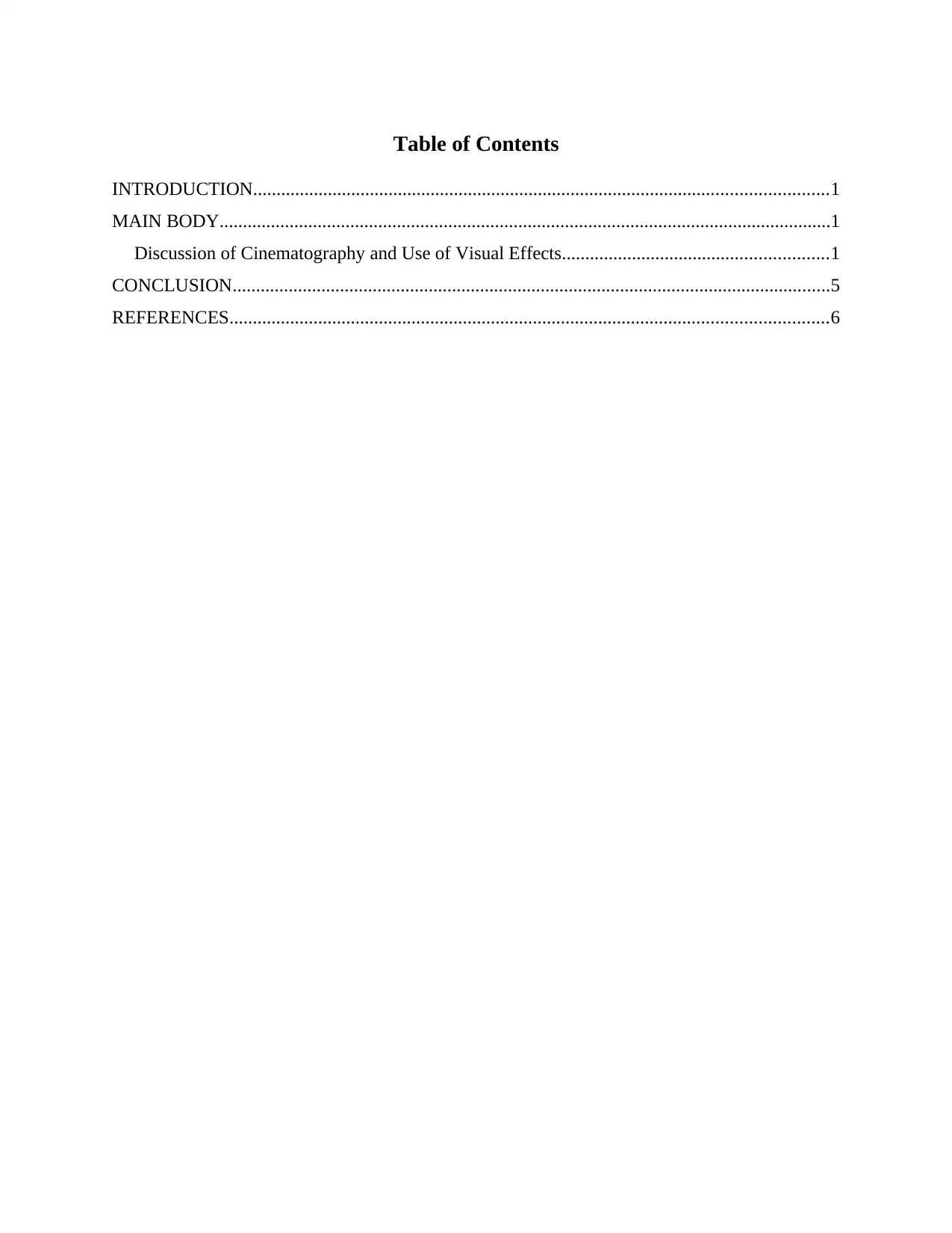
Table of Contents
INTRODUCTION...........................................................................................................................1
MAIN BODY...................................................................................................................................1
Discussion of Cinematography and Use of Visual Effects.........................................................1
CONCLUSION................................................................................................................................5
REFERENCES................................................................................................................................6
INTRODUCTION...........................................................................................................................1
MAIN BODY...................................................................................................................................1
Discussion of Cinematography and Use of Visual Effects.........................................................1
CONCLUSION................................................................................................................................5
REFERENCES................................................................................................................................6
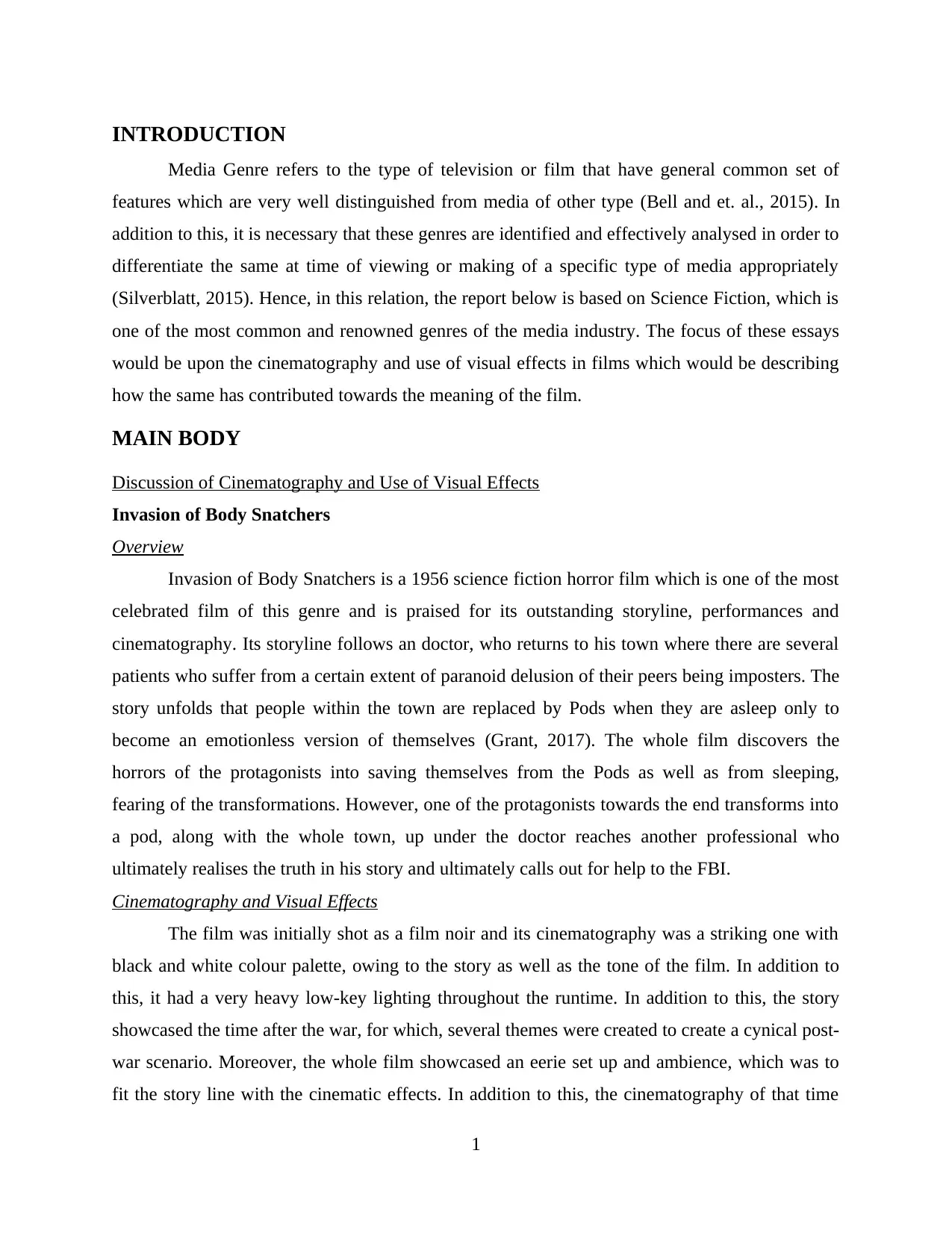
INTRODUCTION
Media Genre refers to the type of television or film that have general common set of
features which are very well distinguished from media of other type (Bell and et. al., 2015). In
addition to this, it is necessary that these genres are identified and effectively analysed in order to
differentiate the same at time of viewing or making of a specific type of media appropriately
(Silverblatt, 2015). Hence, in this relation, the report below is based on Science Fiction, which is
one of the most common and renowned genres of the media industry. The focus of these essays
would be upon the cinematography and use of visual effects in films which would be describing
how the same has contributed towards the meaning of the film.
MAIN BODY
Discussion of Cinematography and Use of Visual Effects
Invasion of Body Snatchers
Overview
Invasion of Body Snatchers is a 1956 science fiction horror film which is one of the most
celebrated film of this genre and is praised for its outstanding storyline, performances and
cinematography. Its storyline follows an doctor, who returns to his town where there are several
patients who suffer from a certain extent of paranoid delusion of their peers being imposters. The
story unfolds that people within the town are replaced by Pods when they are asleep only to
become an emotionless version of themselves (Grant, 2017). The whole film discovers the
horrors of the protagonists into saving themselves from the Pods as well as from sleeping,
fearing of the transformations. However, one of the protagonists towards the end transforms into
a pod, along with the whole town, up under the doctor reaches another professional who
ultimately realises the truth in his story and ultimately calls out for help to the FBI.
Cinematography and Visual Effects
The film was initially shot as a film noir and its cinematography was a striking one with
black and white colour palette, owing to the story as well as the tone of the film. In addition to
this, it had a very heavy low-key lighting throughout the runtime. In addition to this, the story
showcased the time after the war, for which, several themes were created to create a cynical post-
war scenario. Moreover, the whole film showcased an eerie set up and ambience, which was to
fit the story line with the cinematic effects. In addition to this, the cinematography of that time
1
Media Genre refers to the type of television or film that have general common set of
features which are very well distinguished from media of other type (Bell and et. al., 2015). In
addition to this, it is necessary that these genres are identified and effectively analysed in order to
differentiate the same at time of viewing or making of a specific type of media appropriately
(Silverblatt, 2015). Hence, in this relation, the report below is based on Science Fiction, which is
one of the most common and renowned genres of the media industry. The focus of these essays
would be upon the cinematography and use of visual effects in films which would be describing
how the same has contributed towards the meaning of the film.
MAIN BODY
Discussion of Cinematography and Use of Visual Effects
Invasion of Body Snatchers
Overview
Invasion of Body Snatchers is a 1956 science fiction horror film which is one of the most
celebrated film of this genre and is praised for its outstanding storyline, performances and
cinematography. Its storyline follows an doctor, who returns to his town where there are several
patients who suffer from a certain extent of paranoid delusion of their peers being imposters. The
story unfolds that people within the town are replaced by Pods when they are asleep only to
become an emotionless version of themselves (Grant, 2017). The whole film discovers the
horrors of the protagonists into saving themselves from the Pods as well as from sleeping,
fearing of the transformations. However, one of the protagonists towards the end transforms into
a pod, along with the whole town, up under the doctor reaches another professional who
ultimately realises the truth in his story and ultimately calls out for help to the FBI.
Cinematography and Visual Effects
The film was initially shot as a film noir and its cinematography was a striking one with
black and white colour palette, owing to the story as well as the tone of the film. In addition to
this, it had a very heavy low-key lighting throughout the runtime. In addition to this, the story
showcased the time after the war, for which, several themes were created to create a cynical post-
war scenario. Moreover, the whole film showcased an eerie set up and ambience, which was to
fit the story line with the cinematic effects. In addition to this, the cinematography of that time
1
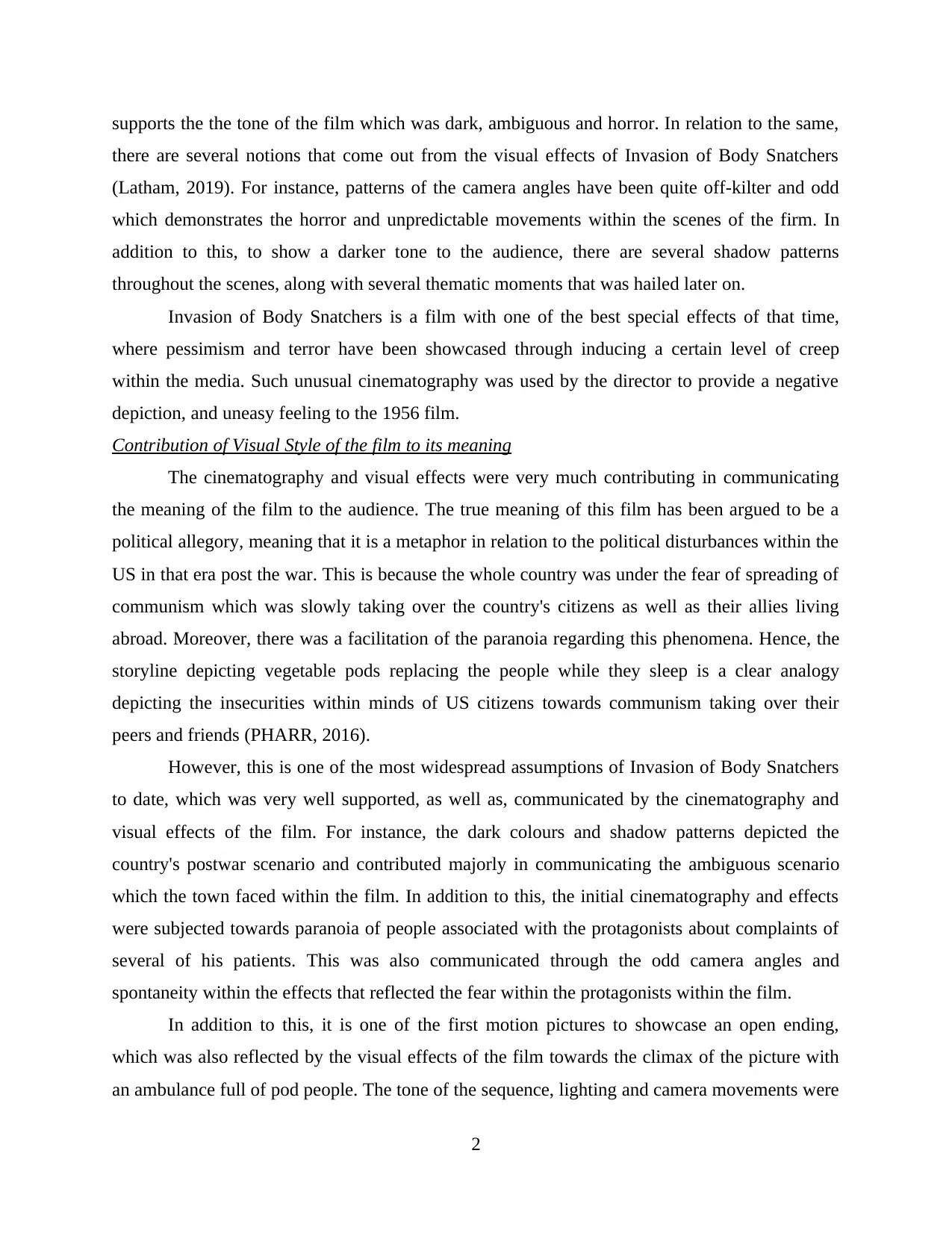
supports the the tone of the film which was dark, ambiguous and horror. In relation to the same,
there are several notions that come out from the visual effects of Invasion of Body Snatchers
(Latham, 2019). For instance, patterns of the camera angles have been quite off-kilter and odd
which demonstrates the horror and unpredictable movements within the scenes of the firm. In
addition to this, to show a darker tone to the audience, there are several shadow patterns
throughout the scenes, along with several thematic moments that was hailed later on.
Invasion of Body Snatchers is a film with one of the best special effects of that time,
where pessimism and terror have been showcased through inducing a certain level of creep
within the media. Such unusual cinematography was used by the director to provide a negative
depiction, and uneasy feeling to the 1956 film.
Contribution of Visual Style of the film to its meaning
The cinematography and visual effects were very much contributing in communicating
the meaning of the film to the audience. The true meaning of this film has been argued to be a
political allegory, meaning that it is a metaphor in relation to the political disturbances within the
US in that era post the war. This is because the whole country was under the fear of spreading of
communism which was slowly taking over the country's citizens as well as their allies living
abroad. Moreover, there was a facilitation of the paranoia regarding this phenomena. Hence, the
storyline depicting vegetable pods replacing the people while they sleep is a clear analogy
depicting the insecurities within minds of US citizens towards communism taking over their
peers and friends (PHARR, 2016).
However, this is one of the most widespread assumptions of Invasion of Body Snatchers
to date, which was very well supported, as well as, communicated by the cinematography and
visual effects of the film. For instance, the dark colours and shadow patterns depicted the
country's postwar scenario and contributed majorly in communicating the ambiguous scenario
which the town faced within the film. In addition to this, the initial cinematography and effects
were subjected towards paranoia of people associated with the protagonists about complaints of
several of his patients. This was also communicated through the odd camera angles and
spontaneity within the effects that reflected the fear within the protagonists within the film.
In addition to this, it is one of the first motion pictures to showcase an open ending,
which was also reflected by the visual effects of the film towards the climax of the picture with
an ambulance full of pod people. The tone of the sequence, lighting and camera movements were
2
there are several notions that come out from the visual effects of Invasion of Body Snatchers
(Latham, 2019). For instance, patterns of the camera angles have been quite off-kilter and odd
which demonstrates the horror and unpredictable movements within the scenes of the firm. In
addition to this, to show a darker tone to the audience, there are several shadow patterns
throughout the scenes, along with several thematic moments that was hailed later on.
Invasion of Body Snatchers is a film with one of the best special effects of that time,
where pessimism and terror have been showcased through inducing a certain level of creep
within the media. Such unusual cinematography was used by the director to provide a negative
depiction, and uneasy feeling to the 1956 film.
Contribution of Visual Style of the film to its meaning
The cinematography and visual effects were very much contributing in communicating
the meaning of the film to the audience. The true meaning of this film has been argued to be a
political allegory, meaning that it is a metaphor in relation to the political disturbances within the
US in that era post the war. This is because the whole country was under the fear of spreading of
communism which was slowly taking over the country's citizens as well as their allies living
abroad. Moreover, there was a facilitation of the paranoia regarding this phenomena. Hence, the
storyline depicting vegetable pods replacing the people while they sleep is a clear analogy
depicting the insecurities within minds of US citizens towards communism taking over their
peers and friends (PHARR, 2016).
However, this is one of the most widespread assumptions of Invasion of Body Snatchers
to date, which was very well supported, as well as, communicated by the cinematography and
visual effects of the film. For instance, the dark colours and shadow patterns depicted the
country's postwar scenario and contributed majorly in communicating the ambiguous scenario
which the town faced within the film. In addition to this, the initial cinematography and effects
were subjected towards paranoia of people associated with the protagonists about complaints of
several of his patients. This was also communicated through the odd camera angles and
spontaneity within the effects that reflected the fear within the protagonists within the film.
In addition to this, it is one of the first motion pictures to showcase an open ending,
which was also reflected by the visual effects of the film towards the climax of the picture with
an ambulance full of pod people. The tone of the sequence, lighting and camera movements were
2
Secure Best Marks with AI Grader
Need help grading? Try our AI Grader for instant feedback on your assignments.
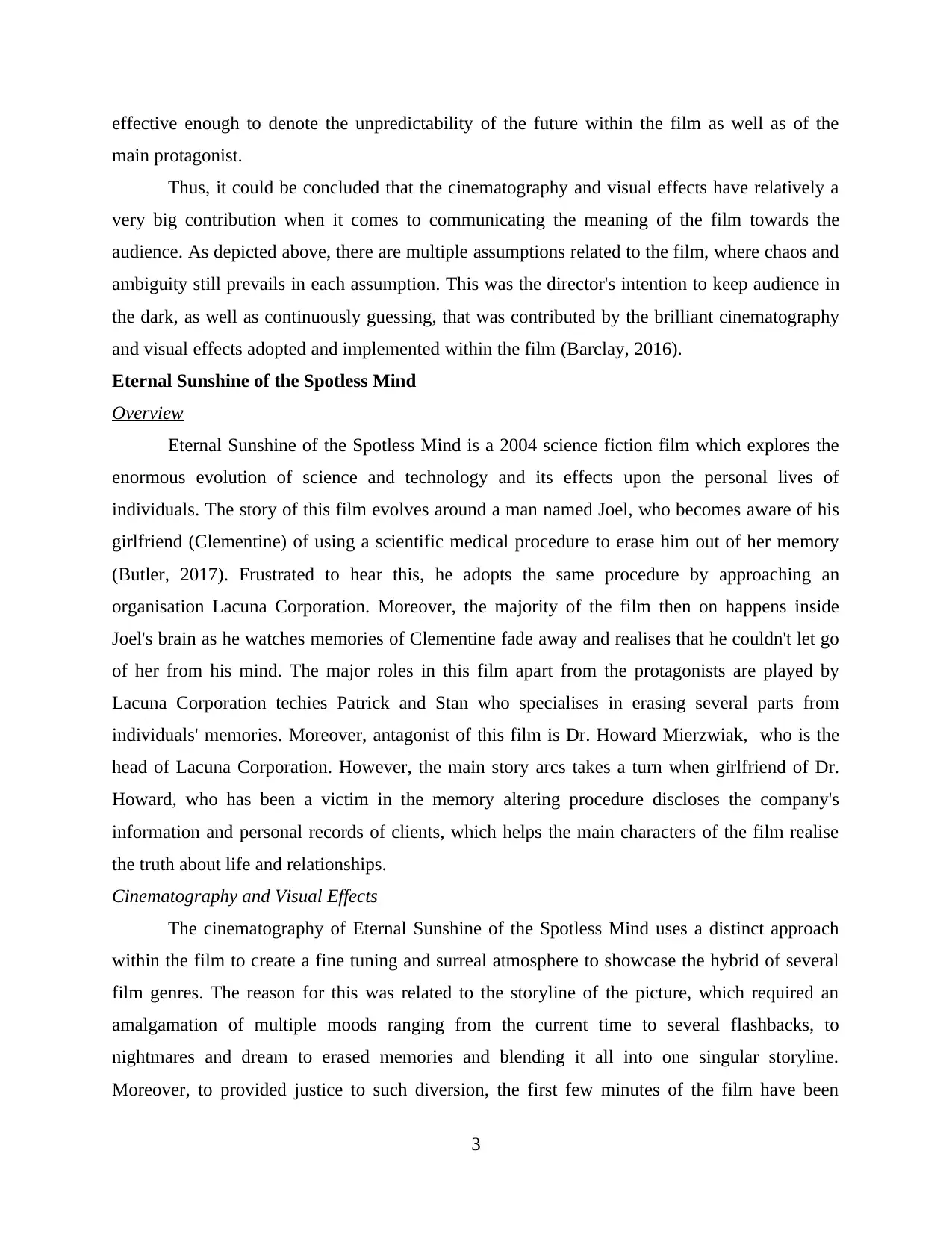
effective enough to denote the unpredictability of the future within the film as well as of the
main protagonist.
Thus, it could be concluded that the cinematography and visual effects have relatively a
very big contribution when it comes to communicating the meaning of the film towards the
audience. As depicted above, there are multiple assumptions related to the film, where chaos and
ambiguity still prevails in each assumption. This was the director's intention to keep audience in
the dark, as well as continuously guessing, that was contributed by the brilliant cinematography
and visual effects adopted and implemented within the film (Barclay, 2016).
Eternal Sunshine of the Spotless Mind
Overview
Eternal Sunshine of the Spotless Mind is a 2004 science fiction film which explores the
enormous evolution of science and technology and its effects upon the personal lives of
individuals. The story of this film evolves around a man named Joel, who becomes aware of his
girlfriend (Clementine) of using a scientific medical procedure to erase him out of her memory
(Butler, 2017). Frustrated to hear this, he adopts the same procedure by approaching an
organisation Lacuna Corporation. Moreover, the majority of the film then on happens inside
Joel's brain as he watches memories of Clementine fade away and realises that he couldn't let go
of her from his mind. The major roles in this film apart from the protagonists are played by
Lacuna Corporation techies Patrick and Stan who specialises in erasing several parts from
individuals' memories. Moreover, antagonist of this film is Dr. Howard Mierzwiak, who is the
head of Lacuna Corporation. However, the main story arcs takes a turn when girlfriend of Dr.
Howard, who has been a victim in the memory altering procedure discloses the company's
information and personal records of clients, which helps the main characters of the film realise
the truth about life and relationships.
Cinematography and Visual Effects
The cinematography of Eternal Sunshine of the Spotless Mind uses a distinct approach
within the film to create a fine tuning and surreal atmosphere to showcase the hybrid of several
film genres. The reason for this was related to the storyline of the picture, which required an
amalgamation of multiple moods ranging from the current time to several flashbacks, to
nightmares and dream to erased memories and blending it all into one singular storyline.
Moreover, to provided justice to such diversion, the first few minutes of the film have been
3
main protagonist.
Thus, it could be concluded that the cinematography and visual effects have relatively a
very big contribution when it comes to communicating the meaning of the film towards the
audience. As depicted above, there are multiple assumptions related to the film, where chaos and
ambiguity still prevails in each assumption. This was the director's intention to keep audience in
the dark, as well as continuously guessing, that was contributed by the brilliant cinematography
and visual effects adopted and implemented within the film (Barclay, 2016).
Eternal Sunshine of the Spotless Mind
Overview
Eternal Sunshine of the Spotless Mind is a 2004 science fiction film which explores the
enormous evolution of science and technology and its effects upon the personal lives of
individuals. The story of this film evolves around a man named Joel, who becomes aware of his
girlfriend (Clementine) of using a scientific medical procedure to erase him out of her memory
(Butler, 2017). Frustrated to hear this, he adopts the same procedure by approaching an
organisation Lacuna Corporation. Moreover, the majority of the film then on happens inside
Joel's brain as he watches memories of Clementine fade away and realises that he couldn't let go
of her from his mind. The major roles in this film apart from the protagonists are played by
Lacuna Corporation techies Patrick and Stan who specialises in erasing several parts from
individuals' memories. Moreover, antagonist of this film is Dr. Howard Mierzwiak, who is the
head of Lacuna Corporation. However, the main story arcs takes a turn when girlfriend of Dr.
Howard, who has been a victim in the memory altering procedure discloses the company's
information and personal records of clients, which helps the main characters of the film realise
the truth about life and relationships.
Cinematography and Visual Effects
The cinematography of Eternal Sunshine of the Spotless Mind uses a distinct approach
within the film to create a fine tuning and surreal atmosphere to showcase the hybrid of several
film genres. The reason for this was related to the storyline of the picture, which required an
amalgamation of multiple moods ranging from the current time to several flashbacks, to
nightmares and dream to erased memories and blending it all into one singular storyline.
Moreover, to provided justice to such diversion, the first few minutes of the film have been
3
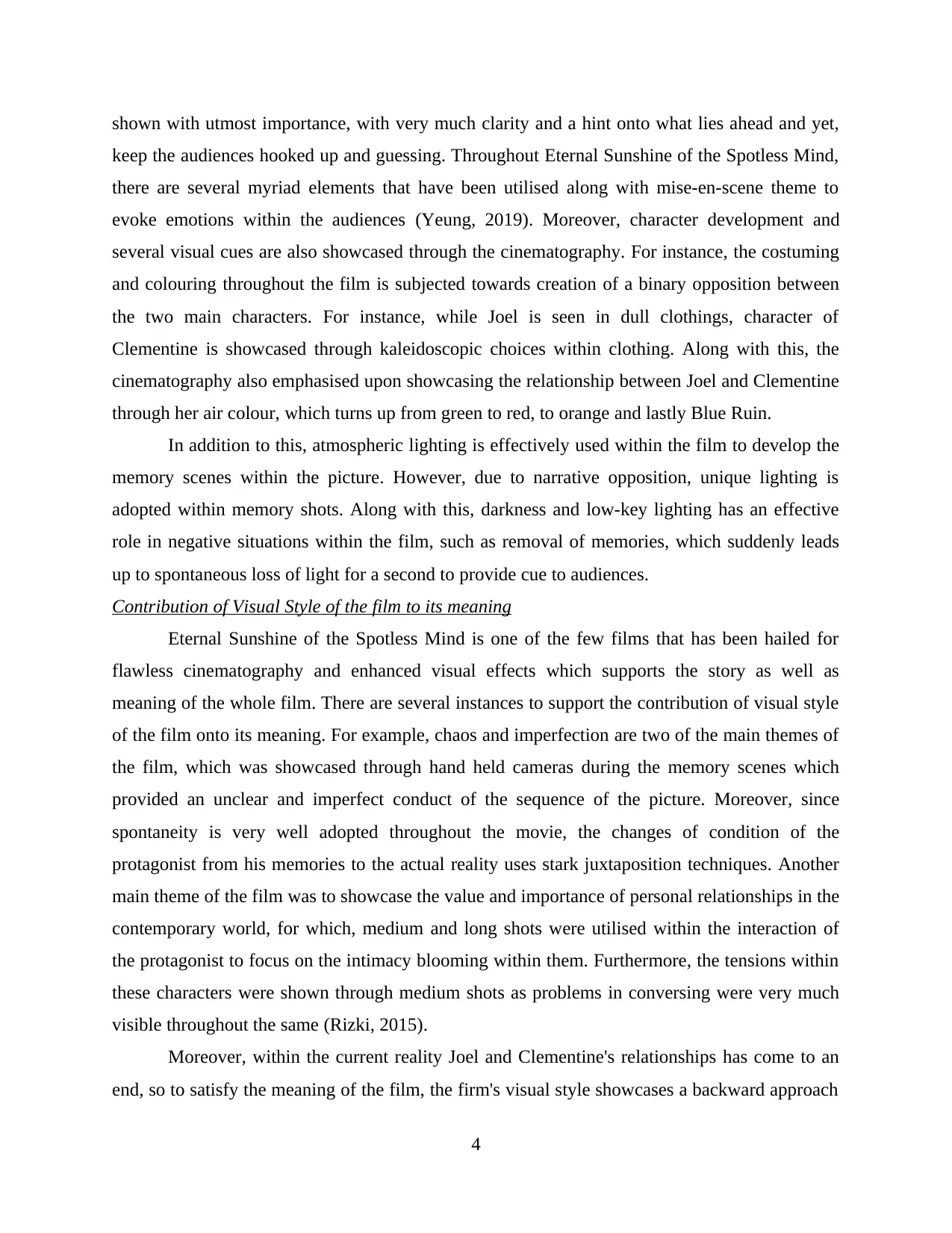
shown with utmost importance, with very much clarity and a hint onto what lies ahead and yet,
keep the audiences hooked up and guessing. Throughout Eternal Sunshine of the Spotless Mind,
there are several myriad elements that have been utilised along with mise-en-scene theme to
evoke emotions within the audiences (Yeung, 2019). Moreover, character development and
several visual cues are also showcased through the cinematography. For instance, the costuming
and colouring throughout the film is subjected towards creation of a binary opposition between
the two main characters. For instance, while Joel is seen in dull clothings, character of
Clementine is showcased through kaleidoscopic choices within clothing. Along with this, the
cinematography also emphasised upon showcasing the relationship between Joel and Clementine
through her air colour, which turns up from green to red, to orange and lastly Blue Ruin.
In addition to this, atmospheric lighting is effectively used within the film to develop the
memory scenes within the picture. However, due to narrative opposition, unique lighting is
adopted within memory shots. Along with this, darkness and low-key lighting has an effective
role in negative situations within the film, such as removal of memories, which suddenly leads
up to spontaneous loss of light for a second to provide cue to audiences.
Contribution of Visual Style of the film to its meaning
Eternal Sunshine of the Spotless Mind is one of the few films that has been hailed for
flawless cinematography and enhanced visual effects which supports the story as well as
meaning of the whole film. There are several instances to support the contribution of visual style
of the film onto its meaning. For example, chaos and imperfection are two of the main themes of
the film, which was showcased through hand held cameras during the memory scenes which
provided an unclear and imperfect conduct of the sequence of the picture. Moreover, since
spontaneity is very well adopted throughout the movie, the changes of condition of the
protagonist from his memories to the actual reality uses stark juxtaposition techniques. Another
main theme of the film was to showcase the value and importance of personal relationships in the
contemporary world, for which, medium and long shots were utilised within the interaction of
the protagonist to focus on the intimacy blooming within them. Furthermore, the tensions within
these characters were shown through medium shots as problems in conversing were very much
visible throughout the same (Rizki, 2015).
Moreover, within the current reality Joel and Clementine's relationships has come to an
end, so to satisfy the meaning of the film, the firm's visual style showcases a backward approach
4
keep the audiences hooked up and guessing. Throughout Eternal Sunshine of the Spotless Mind,
there are several myriad elements that have been utilised along with mise-en-scene theme to
evoke emotions within the audiences (Yeung, 2019). Moreover, character development and
several visual cues are also showcased through the cinematography. For instance, the costuming
and colouring throughout the film is subjected towards creation of a binary opposition between
the two main characters. For instance, while Joel is seen in dull clothings, character of
Clementine is showcased through kaleidoscopic choices within clothing. Along with this, the
cinematography also emphasised upon showcasing the relationship between Joel and Clementine
through her air colour, which turns up from green to red, to orange and lastly Blue Ruin.
In addition to this, atmospheric lighting is effectively used within the film to develop the
memory scenes within the picture. However, due to narrative opposition, unique lighting is
adopted within memory shots. Along with this, darkness and low-key lighting has an effective
role in negative situations within the film, such as removal of memories, which suddenly leads
up to spontaneous loss of light for a second to provide cue to audiences.
Contribution of Visual Style of the film to its meaning
Eternal Sunshine of the Spotless Mind is one of the few films that has been hailed for
flawless cinematography and enhanced visual effects which supports the story as well as
meaning of the whole film. There are several instances to support the contribution of visual style
of the film onto its meaning. For example, chaos and imperfection are two of the main themes of
the film, which was showcased through hand held cameras during the memory scenes which
provided an unclear and imperfect conduct of the sequence of the picture. Moreover, since
spontaneity is very well adopted throughout the movie, the changes of condition of the
protagonist from his memories to the actual reality uses stark juxtaposition techniques. Another
main theme of the film was to showcase the value and importance of personal relationships in the
contemporary world, for which, medium and long shots were utilised within the interaction of
the protagonist to focus on the intimacy blooming within them. Furthermore, the tensions within
these characters were shown through medium shots as problems in conversing were very much
visible throughout the same (Rizki, 2015).
Moreover, within the current reality Joel and Clementine's relationships has come to an
end, so to satisfy the meaning of the film, the firm's visual style showcases a backward approach
4
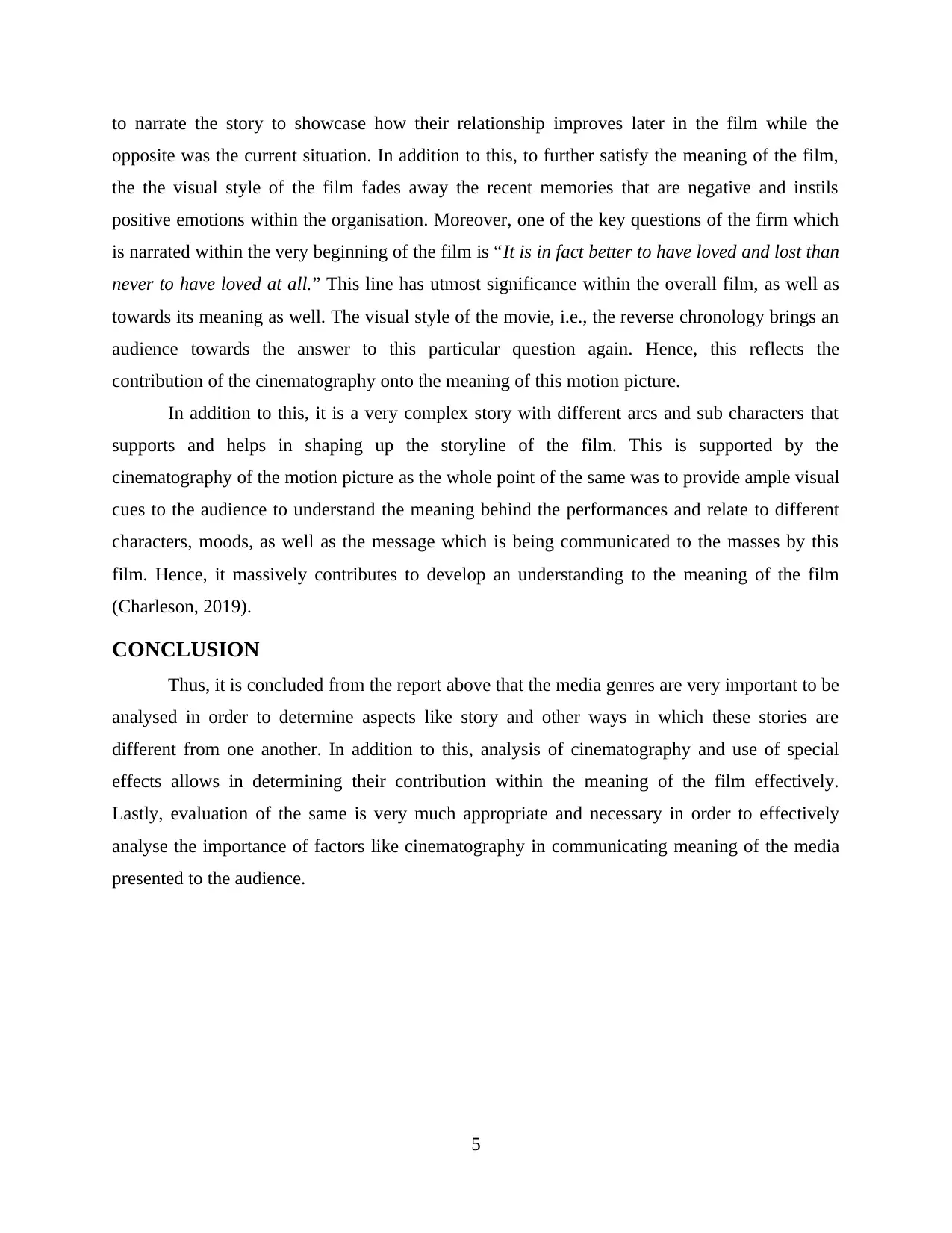
to narrate the story to showcase how their relationship improves later in the film while the
opposite was the current situation. In addition to this, to further satisfy the meaning of the film,
the the visual style of the film fades away the recent memories that are negative and instils
positive emotions within the organisation. Moreover, one of the key questions of the firm which
is narrated within the very beginning of the film is “It is in fact better to have loved and lost than
never to have loved at all.” This line has utmost significance within the overall film, as well as
towards its meaning as well. The visual style of the movie, i.e., the reverse chronology brings an
audience towards the answer to this particular question again. Hence, this reflects the
contribution of the cinematography onto the meaning of this motion picture.
In addition to this, it is a very complex story with different arcs and sub characters that
supports and helps in shaping up the storyline of the film. This is supported by the
cinematography of the motion picture as the whole point of the same was to provide ample visual
cues to the audience to understand the meaning behind the performances and relate to different
characters, moods, as well as the message which is being communicated to the masses by this
film. Hence, it massively contributes to develop an understanding to the meaning of the film
(Charleson, 2019).
CONCLUSION
Thus, it is concluded from the report above that the media genres are very important to be
analysed in order to determine aspects like story and other ways in which these stories are
different from one another. In addition to this, analysis of cinematography and use of special
effects allows in determining their contribution within the meaning of the film effectively.
Lastly, evaluation of the same is very much appropriate and necessary in order to effectively
analyse the importance of factors like cinematography in communicating meaning of the media
presented to the audience.
5
opposite was the current situation. In addition to this, to further satisfy the meaning of the film,
the the visual style of the film fades away the recent memories that are negative and instils
positive emotions within the organisation. Moreover, one of the key questions of the firm which
is narrated within the very beginning of the film is “It is in fact better to have loved and lost than
never to have loved at all.” This line has utmost significance within the overall film, as well as
towards its meaning as well. The visual style of the movie, i.e., the reverse chronology brings an
audience towards the answer to this particular question again. Hence, this reflects the
contribution of the cinematography onto the meaning of this motion picture.
In addition to this, it is a very complex story with different arcs and sub characters that
supports and helps in shaping up the storyline of the film. This is supported by the
cinematography of the motion picture as the whole point of the same was to provide ample visual
cues to the audience to understand the meaning behind the performances and relate to different
characters, moods, as well as the message which is being communicated to the masses by this
film. Hence, it massively contributes to develop an understanding to the meaning of the film
(Charleson, 2019).
CONCLUSION
Thus, it is concluded from the report above that the media genres are very important to be
analysed in order to determine aspects like story and other ways in which these stories are
different from one another. In addition to this, analysis of cinematography and use of special
effects allows in determining their contribution within the meaning of the film effectively.
Lastly, evaluation of the same is very much appropriate and necessary in order to effectively
analyse the importance of factors like cinematography in communicating meaning of the media
presented to the audience.
5
Paraphrase This Document
Need a fresh take? Get an instant paraphrase of this document with our AI Paraphraser
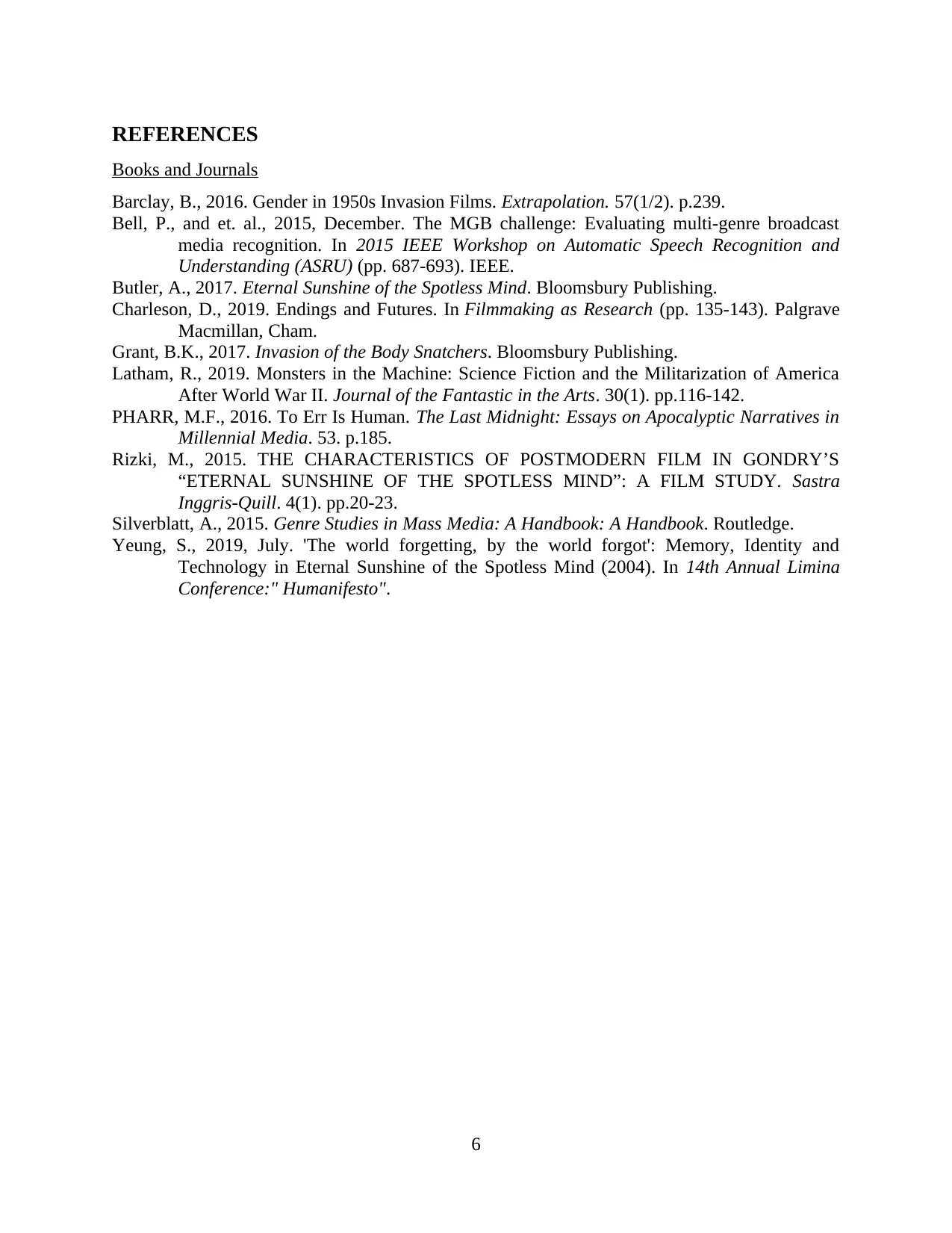
REFERENCES
Books and Journals
Barclay, B., 2016. Gender in 1950s Invasion Films. Extrapolation. 57(1/2). p.239.
Bell, P., and et. al., 2015, December. The MGB challenge: Evaluating multi-genre broadcast
media recognition. In 2015 IEEE Workshop on Automatic Speech Recognition and
Understanding (ASRU) (pp. 687-693). IEEE.
Butler, A., 2017. Eternal Sunshine of the Spotless Mind. Bloomsbury Publishing.
Charleson, D., 2019. Endings and Futures. In Filmmaking as Research (pp. 135-143). Palgrave
Macmillan, Cham.
Grant, B.K., 2017. Invasion of the Body Snatchers. Bloomsbury Publishing.
Latham, R., 2019. Monsters in the Machine: Science Fiction and the Militarization of America
After World War II. Journal of the Fantastic in the Arts. 30(1). pp.116-142.
PHARR, M.F., 2016. To Err Is Human. The Last Midnight: Essays on Apocalyptic Narratives in
Millennial Media. 53. p.185.
Rizki, M., 2015. THE CHARACTERISTICS OF POSTMODERN FILM IN GONDRY’S
“ETERNAL SUNSHINE OF THE SPOTLESS MIND”: A FILM STUDY. Sastra
Inggris-Quill. 4(1). pp.20-23.
Silverblatt, A., 2015. Genre Studies in Mass Media: A Handbook: A Handbook. Routledge.
Yeung, S., 2019, July. 'The world forgetting, by the world forgot': Memory, Identity and
Technology in Eternal Sunshine of the Spotless Mind (2004). In 14th Annual Limina
Conference:" Humanifesto".
6
Books and Journals
Barclay, B., 2016. Gender in 1950s Invasion Films. Extrapolation. 57(1/2). p.239.
Bell, P., and et. al., 2015, December. The MGB challenge: Evaluating multi-genre broadcast
media recognition. In 2015 IEEE Workshop on Automatic Speech Recognition and
Understanding (ASRU) (pp. 687-693). IEEE.
Butler, A., 2017. Eternal Sunshine of the Spotless Mind. Bloomsbury Publishing.
Charleson, D., 2019. Endings and Futures. In Filmmaking as Research (pp. 135-143). Palgrave
Macmillan, Cham.
Grant, B.K., 2017. Invasion of the Body Snatchers. Bloomsbury Publishing.
Latham, R., 2019. Monsters in the Machine: Science Fiction and the Militarization of America
After World War II. Journal of the Fantastic in the Arts. 30(1). pp.116-142.
PHARR, M.F., 2016. To Err Is Human. The Last Midnight: Essays on Apocalyptic Narratives in
Millennial Media. 53. p.185.
Rizki, M., 2015. THE CHARACTERISTICS OF POSTMODERN FILM IN GONDRY’S
“ETERNAL SUNSHINE OF THE SPOTLESS MIND”: A FILM STUDY. Sastra
Inggris-Quill. 4(1). pp.20-23.
Silverblatt, A., 2015. Genre Studies in Mass Media: A Handbook: A Handbook. Routledge.
Yeung, S., 2019, July. 'The world forgetting, by the world forgot': Memory, Identity and
Technology in Eternal Sunshine of the Spotless Mind (2004). In 14th Annual Limina
Conference:" Humanifesto".
6
1 out of 8
Your All-in-One AI-Powered Toolkit for Academic Success.
+13062052269
info@desklib.com
Available 24*7 on WhatsApp / Email
![[object Object]](/_next/static/media/star-bottom.7253800d.svg)
Unlock your academic potential
© 2024 | Zucol Services PVT LTD | All rights reserved.